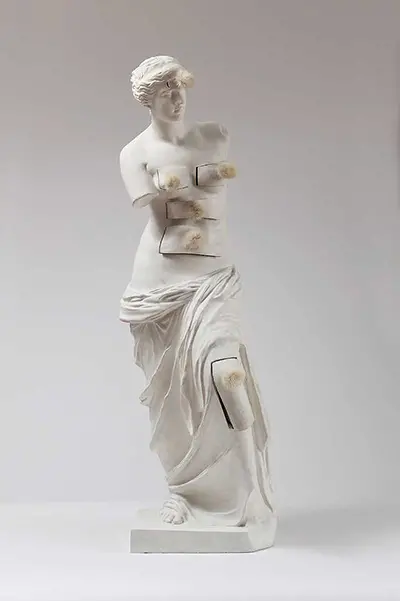Venus de Milo is considered as one of his most famous works. It features a half-sized copy of a woman decorated with a chest of drawers. He painted this sculpture with white plaster to make it look like marble. Salvador Dali marked and cut apertures in several places on the sculpture with the intent to fit drawers. He consequently paid a carpenter recommended by Marcel Duchamp to create the drawers. The apertures are located on the sculpture's forehead, one on each breast, two on the abdomen, and one on the left bent knee. He also decorated the drawers with white mink fur.
Using the body of a woman as a cabinet is a metaphor materialised in the artistic work of uncanny juxtapositions of personified the unconscious, open and closed as well as hard and soft. In explanation, these are the common aspects of life where you people reveal and conceal their deepest desires. These facts can be seen and felt by people viewing the sculpture as they are drawn to the half-open drawers with the intent to have a glimpse of what’s inside, but the woman (in this case the personalised body) is reluctant to let them see. The silky knobs beg to be caressed; thus, they are able to express the desire to feel and know. As such, the image creates a feeling similar to the mandate to "Look but Don’t Touch" in a sexually explicit manner.
However, the deeper meaning of the sculpture illustrates the uncanny thoughts and emotional perception of Salvador Dali. This artistic work aimed to provide art lovers with a surprising valuable lesson that will captivate the viewer's consciously conservative thoughts by forcing them to contemplate the temporality of life. In itself, the image is supposed to initiate awareness of one's death and the anxiety that affect people when they want to express their deep thoughts. In simple terminology, Dali wanted people to open up and confront their deepest fears, desires as well any subconscious troubles they may be facing before facing their death. The sculpture is located in Musée de Louvre—the world's largest art museum.
Salvador Dali created the first variation of Venus de Milo with Drawers. Instead of a sculpture, he used oil paint to draw a similar image on a large piece of wood. The paint depicted Venus de Milo as a large cabinet with six drawers. Her figure, however, was more voluptuous and muscular. In the painting, the woman is sited with her legs stretched outs, the upper body leaning on the one side with the right up supporting it. The other arm is stretched out forward. Her head bends forward with her long hair cascading into the partially opened drawers. Other variations depict her with arms and other when holding a baby.
Who Influenced Salvador Dali's Work, and Who Were Inspired by Him
With the use of morphology in his early work, it’s clear that his art bore some resemblance to Pablo Picasso and Joan Miró. In his painting, you can also see a fascination for renaissance and classical art portrayed through his hyper-realistic style and religious symbolism. Salvador Dali also influenced several people through his art. These people include:
Paul Eluard - Paul Eluard was among the founder of the Surrealist Movement. The sexual representation especially inspired Eluard in lots of Dali’s artwork. The lack of conventionality in Dali's work led Eluard, Breton and Aragon to invite him to join their movement.
Garcia Lorca - Garcia was an avant-garde poet who has so much in common with Dali. The similarity in their commonness formed the very basis of their friendship and inspired some poets. Lorca would also appear in some ways in Dali’s art after his assassination.
Luis Buñuel - As a filmmaker, Buñuel derived from Dali’s inspiration of surrealism and approached with an idea of a film. This flick had one strict rule that no explanation was offered on the ideas and actions in the Film. Buñuel was inspired by Dali’s way of thinking that he explored surrealism for himself.
Gala Dali - Perhaps the most famous of all people who were influenced and inspired Dali was his wife Gala, who was featured in most of his artwork. Dali was accused of using some of Gala’s features on Jesus in his last supper portrait. Gala was a leading cause of some of Dali's best and worst art pieces.

